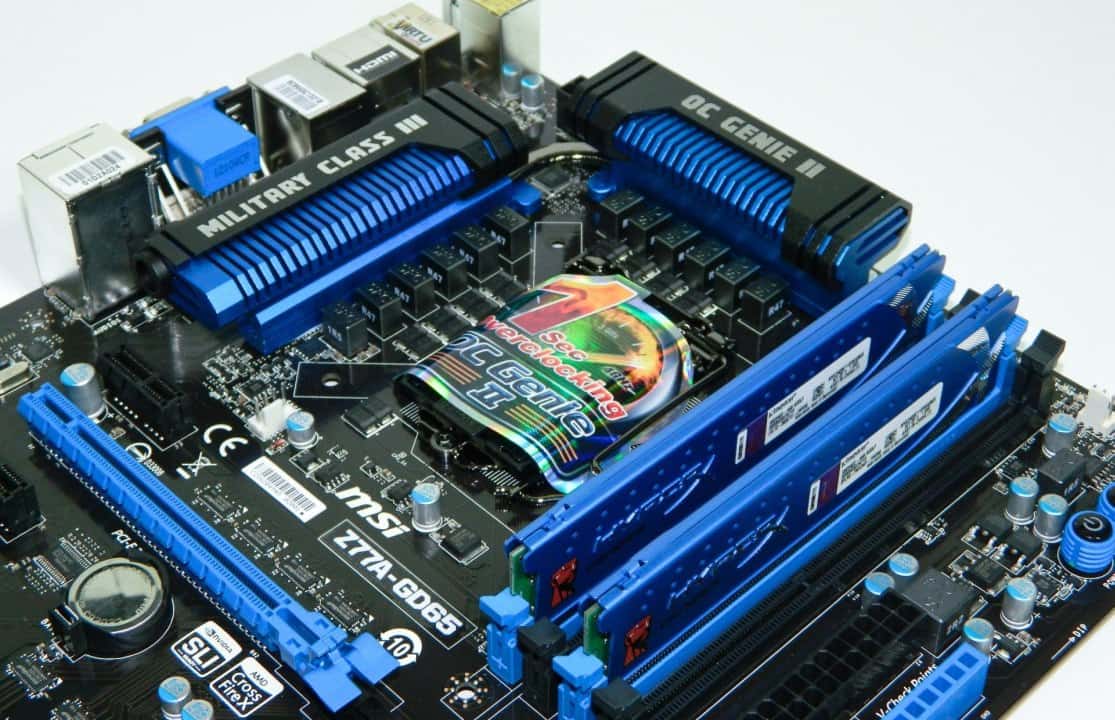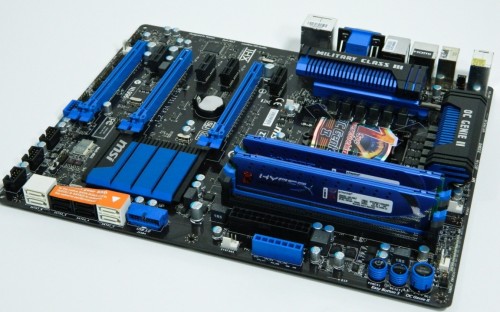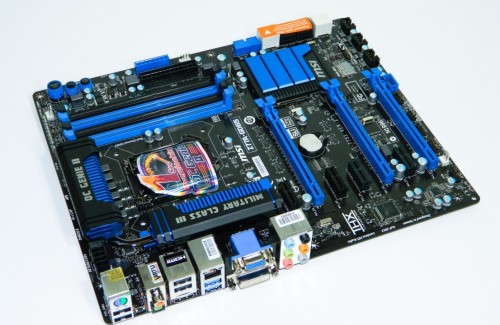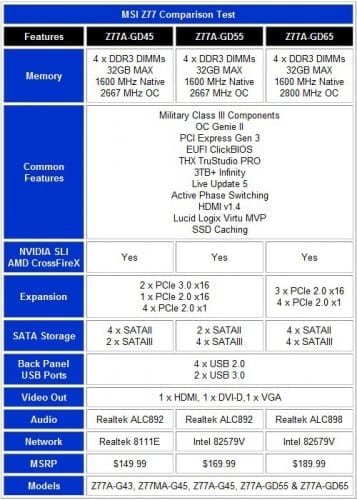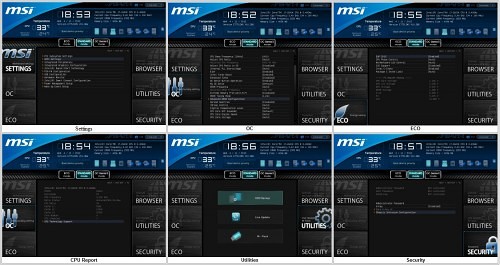What is Z77 and what does it do? It’s Intel’s latest motherboard chipset (codenamed Panther Point) that supports Intel’s 2nd Generation Sandy Bridge processors, but was actually designed for their new Ivy Bridge LGA1155 3rd Generation parts, which we’ll touch on a bit later. For now, our focus is on MSI’s entry to the Z77 arena, the Z77A-GD65 Military Class III motherboard which sports a new UEFI BIOS and updated desktop software.
We previewed this board a few weeks ago to give you a quick taste of what big features MSI had coming. While we can’t show you any Ivy Bridge benchmarks as of yet, we are going to see if some of the new features like PCIE 3.0 as well as overclocking with Sandy Bridge Processors, will make this board a worthy upgrade for anyone still clutching a P67 based board.
Features and Specifications
Those familiar with MSI know about their easy to use OC Genie II overclocking button plus an automated OC Genie II option in the BIOS which now includes customizable profile settings. The ClickBIOS II offers a new GUI along with a new layout. These are supported by new Military Class III VRM which should add an extra level of overclocking stability. As a Z77 board, it also has native USB 3.0 ports, along with the return of Intel Smart Response, and Intel’s Quick Sync to speed up video encoding on LGA1155 processors.
The included Lucid Virtu MVP technology builds upon the original Lucid Virtu that came on Z68. The new version helps to increase frame rates with the new HyperPerformance Technology which reduces redundancy in GPU rendering, and pairs that with Virtual VSync which gives you increased picture quality without sacrificing frame rate. It’s like having Vsync on without the down sides. We’ll look at this more in depth in a later article.
MSI will be starting with four of the Panther Point family chipsets. The peformance series will include Z77 and a more cost effective Z75. For the mainstream market, we’ll see a an H77 geared more towards multimedia, and a B75 chipset respectively geared more towards business. As of right now, pricing for the Z77A-GD55 starts at $169.99 and Z77A-GD65 at $189.99 US/CA.
UEFI and ClickBIOS II
The new EUFI BIOS is well organized and easy to use. It’s broken down in to six appropriately labeled tabs. Interacting with the mouse is very easy and more responsive than before. However, there aren’t any onscreen explanations for individual settings within the tabs. Those unfamiliar with certain settings will require the manual. The EUFI BIOS image is large enough to hold detailed data for a better user experience so hopefully we see that in a later update.
The Settings tab contains all the chipset triggers which includes expansion, peripherals, storage and hardware monitoring. The OC (overclocking) tab contains CPU, memory, OC Genie and voltage options. The ECO tab has all the settings for controlling power consumption. The Browser tab will allow you message and mail once you install the software. The Utilities tab has options for accessing Live Update and M-Flash for updating the motherboard BIOS. Security is there for setting up a protective password, chassis intrusion and U-Key which makes a USB flash drive your magical key needed to access the system.
Using the ClickBIOS II in Windows wasn’t as fluid. It took my test system about 85 seconds (1 minute 25 seconds) to load the program. As the program loads, the system sometimes seems unresponsive which is okay given it’s communicating with some very sensitive motherboard code. Once it’s running, you can manipulate most everything that’s in the UEFI BIOS, but from the Windows Desktop. This is useful for those times when you want to change a setting that isn’t worth rebooting for. Like disabling serial ports or something.
Test System Setup
Since Sandy Bridge CPUs are supposes to fly on all Intel Z77 chipsets, I’m including scores gathered from Intel’s DZ77GA-70K motherboard. Both of these boards should impress us with their elite numbers. The Intel DP67BG Extreme motherboard is also being used as it’s the chipset I recommend upgrading from if you need more expansion and performance and are looking at Z77 as a cost effective option.
- Processor: Intel Core i7-2600K 2nd Generation Sandy Bridge
- Motherboard 1: MSI Z77A-GD65 Military Class III (A36 BIOS)
- Motherboard 2: Intel DZ77GA-70K Extreme (GZZ7710H.86A BIOS)
- Motherboard 3: Intel DP67BG Extreme Motherboard
- Memory: Kingston HyperX Genesis 4GB 2133MHz DDR3 @ 1333 MHz
- Graphics: MSI GTX 560 Ti TwinFrozrII SLI
- SATA2/SATA3 Storage: Kingston HyperX 120GB SSD
- USB 3.0 Storage: Thermaltake 5G Docking Station
- Power: Antec CP-850 Power Supply
- Cooling: NZXT HAVIK 140
- OS: Windows 7 Pro 64-bit
- Drivers/Software: NVIDIA 297.15 Graphics, Intel Rapid Storage and 1019 Intel Chipset
We’re curious if the MSI Z77A-GD65 really does support Sandy Bridge as nicely as we’ve heard. One side of engineers say overclocking will be just as good as P67/Z68 or even better. The other side says that Z77 is more tuned to set records with the new Ivy Bridge so don’t be surprised if our 2600K doesn’t do as well. Bullshavick! Let’s find out.
Benchmark Notes
SANDRA Mathematical and Multimedia, Graysky H.264 4.0 Benchmark, Cinebench R11.5, PCMark7, Media Espresso 6, Batman Arkham City, AVP Benchmark and Unigine Heaven will all be in the mix today. Keep in mind that most of the system performance is due to the processor given that everything is completely integrated in to the CPU. What we’re interested in is whether Z77 is passive or actually improves performance overall.

